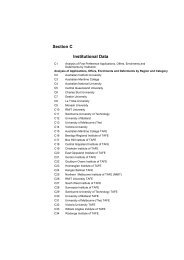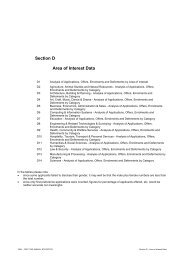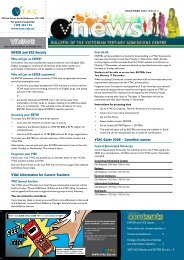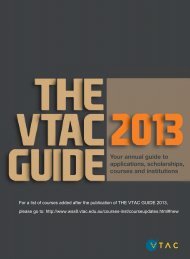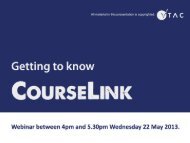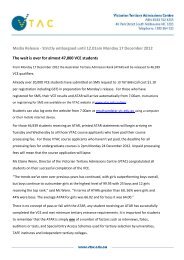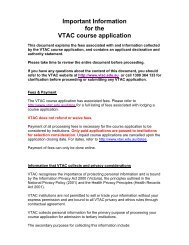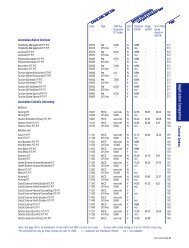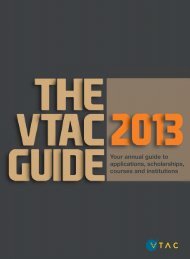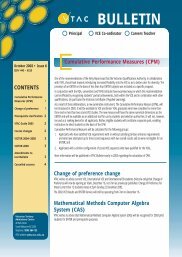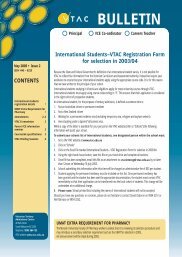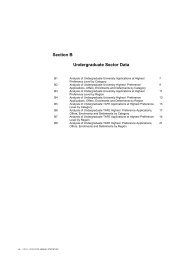VTAC Bulletin - July 2004
VTAC Bulletin - July 2004
VTAC Bulletin - July 2004
- No tags were found...
Create successful ePaper yourself
Turn your PDF publications into a flip-book with our unique Google optimized e-Paper software.
www.vtac.edu.au<strong>VTAC</strong><strong>Bulletin</strong><strong>July</strong> <strong>2004</strong>Issue 3ISSN 1445 – 8225ContentsPrincipal Careers Teacher Year 12 Co-ordinatorApplicationspen!SEAS 1–22005 Initiatives 22005 New course update 3Amendments 3–4<strong>VTAC</strong> course codestructure 42005 <strong>VTAC</strong> applications 4Seminars 6Higher EducationReforms 7Applications for tertiary courses open 9am Monday 26 <strong>July</strong> <strong>2004</strong>ContactsApplicant enquiries:> General: 1300 364 133> <strong>VTAC</strong> website: www.vtac.edu.au> <strong>VTAC</strong> Infoline: 1902 241 114 at 82.5 cents per minute> <strong>VTAC</strong> LateLine: 1902 210 145 at $5.50 per minute> To register for Vnews: www.vtac.edu.au<strong>VTAC</strong> briefing schedule 8Copies of previousbulletins are available at:www.vtac.edu.auSpecial Entry Access Schemes (SEAS)OverviewThe Special Entry Access Scheme (SEAS) has been launched for the 2005 selection period.Now, for the first time:> An umbrella program for special entry schemes conducted by participating tertiary institutions is available inVictoria.> All information is available from a single source, the SEAS booklet.The majority of institutions operate schemes designed to address issues of access and equity relating to entry intoundergraduate courses. In fact some institutions set aside a proportion of their annual intake for students who arenot able to reach their full potential due to circumstances beyond their control. This does not mean that all studentswho can demonstrate adverse circumstances are admitted to their course of choice. Applicants still compete withothers within special entry schemes.Institutions also acknowledge types of disadvantage that may have affected students in the final year of secondaryschooling and which fall outside of programs available through the secondary school structures. This allowsconsideration of Year 12 chronic circumstances.Applicants who believe their circumstances may not be addressed by SEAS are advised to talk to <strong>VTAC</strong> or theinstitutions to which they are applying. Questions about details of these schemes must be directed to the nominatedcontact person at the relevant institution.Applicants for SEAS must have made application for course admission through <strong>VTAC</strong> or included the course atChange of Preference. Applicants who wish to access SEAS must be able to support their claims with the requiredevidence. Institutions are responsible for evaluation of applications.Applications for this scheme close on Friday 8 October <strong>2004</strong>.@<strong>VTAC</strong>40 Park StreetSouth Melbourne 3205Telephone: 1300 364 133
SEAS ...continuedHow SEAS is structuredThere are two distinct and separate SEAS schemes with an accessscholarship component for specific universities only:> SEAS access and equity schemes (incorporating accessscholarship applications for Deakin University and TheUniversity of Melbourne).> SEAS Year 12 chronic circumstances scheme.SEAS access and equity schemes(incorporating access scholarship applications for DeakinUniversity and The University of Melbourne)Access and equity schemes are targeted at applicants who havebeen unable to reach their full educational potential or who mayhave access to the courses of their choice restricted because of lifecircumstances. This application is composed of ten categories.Scholarships: Most institutions and all universities offerscholarships of some kind. As part of these scholarships, theCommonwealth is offering Commonwealth Learning Scholarships(CLS). The basic eligibility criteria for the CLS are detailed in theSEAS booklet or on university websites.Currently, Deakin University and The University of Melbourneare the only universities using the SEAS application processfor scholarship applications. Applicants should access specificscholarship eligibility criteria for each of these universities from theirentry in the SEAS booklet.All other institutions have direct application processes for thescholarships they are offering including the CommonwealthLearning Scholarships (CLS). Applicants to these institutions shouldaccess the website of the institution to which they are applying anduse the appropriate application process.SEAS Year 12 chronic circumstances schemeThis scheme assists those students who have experiencedcircumstances which have had an adverse impact on the final yearof their secondary school performance.Who may applySEAS access and equity schemes(incorporating access scholarship applications for DeakinUniversity and The University of Melbourne)Eligibility criteria for the access and equity application categoriesare described in the institutional entries in the booklet. Someapplicant categories have very specific criteria while others havemore general requirements. Some institutions also have additionalrequirements for example interview, institutional forms.SEAS Year 12 chronic circumstances schemeEligibility criteria for Year 12 chronic circumstances are described below.How to applySEAS access and equity schemes(incorporating access scholarship applications for DeakinUniversity and The University of Melbourne)To be considered under the access and equity schemes (and forassociated scholarships at Deakin University or The University ofMelbourne), applicants must complete the SEAS access and equityapplication.Applicants may complete more than one category of the SEAS accessand equity application however if an applicant submits more than oneof this application then institutions reserve the right to process only one.SEAS Year 12 chronic circumstances schemeTo be considered under the Year 12 chronic circumstances scheme,complete the SEAS Year 12 chronic circumstances application.This application covers a range of circumstances that may beconsidered in the selection process by institutions together with thesupporting evidence required.If more than one application is submitted, institutions reserve theright to process only one.When to applyAll SEAS applications close on Friday 8 October <strong>2004</strong>.Applications may be lodged at any time prior to that date. It isrecommended that any documentary evidence required be attachedto and submitted with applications where possible.2005 InitiativesIrregular Offer formApplicants will now be able to download their own personalApplication for Irregular Offer from the <strong>VTAC</strong> Infonet. Additionalcopies of the form are only available from the office of <strong>VTAC</strong>.Update on Non-year 12 application processNon-year 12 applicants chances of submitting an accurateapplication have now increased ten fold with the exclusive moveby <strong>VTAC</strong> to online applications. As a non-year 12 applicant youwill reap the same benefits as current year 12 students withan application process that prompts you to answer all relevantquestions and provides information and advice on how to get yourapplication right the first time.To apply online visit www.vtac.edu.auFor detailed information about costs and deadlines refer towww.vtac.edu.auIf you don’t personally have Internet access don’t forget that accessis available at libraries, many universities and TAFE institutes,neighbourhood and community houses or your local Internet café.PIN and Application numberWhen you apply online you get your own PIN. Your applicationnumber will be allocated at the end of the process. If you forgetyour PIN, you will need to complete the Request for PIN form andreturn it to <strong>VTAC</strong>.HECS coursesHECS courses are now called Commonwealth Supported Places(CSP). For further information about the Federal Governmentinitiatives refer to page 7 of this <strong>Bulletin</strong>.ENTER statementsOnly VCE students who have applied and payed their processingfee will receive a copy of their ENTER statement.Irrespective of whether a VCE student has paid, they will be ableto obtain their ENTER from the Results and ENTER Service. TheResults and ENTER service will be available from 7am on Monday13 December <strong>2004</strong>.Change of preference and processing feesApplicants will not have access to the Change of Preference facility untilall processing and other (if applicable) outstanding fees have been paid.2 <strong>VTAC</strong> <strong>Bulletin</strong>
2005 New course updateThe following courses will be offered through the <strong>VTAC</strong> system forthe 2005 selection period. While their details are not included in the<strong>VTAC</strong> Guide, further information can be found on our website.University of Tasmania• Antarctic StudiesUni of Tas, Sandy Bay (Hobart): 48191 (CSP)Title and length: Bachelor of Antarctic Studies: FT3, PTA.The course has two streams – Antarctic Life Sciences orAntarctic Physical Sciences – allowing for different emphases inspecialisation and preparing students for employment in eitherscientific or policy-related areas.Prerequisites: There are no prerequisite studies.Further information about this course can be found atwww.vtac.edu.au• Environmental ScienceUni of Tas, Newnham (Launceston): 48201 (CSP)Title and length: Bachelor of Environmental Science: FT3, PTA.The Bachelor of Environmental Science is a multi-disciplinarydegree combining the disciplines of biology, chemistry,ecology and physical geography complemented with studiesin environmental policy and management. The program willtrain graduates in monitoring, management and remediation ofindustrial and urban environments.Prerequisites: Units 3 and 4 – a study score of at least 20 inchemistry and in one of mathematical methods or specialistmathematics.Further information about this course can be found atwww.vtac.edu.au• PsychologyUni of Tas, Newnham (Launceston): 48211 (CSP)Uni of Tas, Sandy Bay (Hobart): 48221 (CSP)Title and length: Bachelor of Psychology: FT4, PTA.The Bachelor of Psychology introduces students to theapplications of psychology. Three streams of specialisationin psychology will be offered: clinical and health psychology;neuroscience and applied psychology (environmental psychology,organisational psychology, forensic psychology, educationalpsychology, sport psychology). The neuroscience specialisationwill be available on the Hobart campus only.Prerequisites: There are no prerequisite studies.Further information about this course can be found atwww.vtac.edu.au• Music StudiesUni of Tas, Sandy Bay (Hobart): 48241 (CSP)Title and length: Bachelor of Music Studies: FT3, PTAPrerequisites: There are no prerequisite studies.Further information about this course can be found atwww.vtac.edu.au• Music/LawUni of Tas, Sandy Bay (Hobart): 48251 (CSP)Title and length: Bachelor of Music/Bachelor of Laws: FT5, PTAPrerequisites: There are no prerequisite studies.Further information about this course can be found atwww.vtac.edu.auAmendments to course entries<strong>VTAC</strong> Guide 2005Swinburne UniversitySwinburne University wishes to advise applicants that since thepublication of the <strong>VTAC</strong> Guide, the following course has beenrestructured:• eCommerce (p. 291)Swinburne Uni, Lilydale 35241 (CSP) 35242 (Fee), 35243 (Int. Fee)Title and Length: Bachelor of Business (eCommerce): FT3.Provides graduates with the skills and abilities for professionalcareers in eCommerce.Prerequisite: Units 3 and 4 – a study score of at least 25 inEnglish (any).Selection mode: CY12: ENTER. NONY12: GPA considered (seepage 285 of the <strong>VTAC</strong> Guide 2005)Course structure: FT: Six academic semesters with four subjectsper semester including common core subjects in first year.Combines a major in eCommerce and a minor in eEnterprise.Practical experience: An optional and additional one year orsix months of paid, supervised industry-based learning (normallytaken after second year).Major studies: E-commerce.Additional information: Deferment of offers is not accepted. Forfurther information see www.swin.edu.au/coursefinderImportant notice: IB studentsDue to circumstances outside the control of <strong>VTAC</strong>, the IBcandidate number has changed to include numerical andalphabetical characters.This means that IB students will only be able to access the<strong>VTAC</strong> Infonet (online application) and not the telephoneservice.<strong>VTAC</strong> apologises for this inconvenience, unfortunatelyadmission centres in Australia were not notified and finaldetails are yet to be conveyed from Cardiff.www.vtac.edu.au3 <strong>VTAC</strong> <strong>Bulletin</strong>
Amendments ...continuedVICTER 2006Monash College• Art and Design Studies (p. 71)Old prerequisite statement: Units 1 and 2 – English (any).New prerequisite statement: Units 3 and 4 – a study score of atleast 25 in English (any).• Business (Business) (p. 71)Old prerequisite statement: Units 1 and 2 – mathematics (any)and English (any).New prerequisite statement: Units 3 and 4 – a study score of atleast 25 in mathematics (any) and in English (any).• Business (Commerce) (p. 71)Old prerequisites statement: Units 1 and 2 – mathematics (any)and English (any).New prerequisite statement: Units 3 and 4 – a study score of atleast 25 in mathematical methods or specialist mathematics andin English (any).• Engineering Studies (p. 71)Old prerequisite statement: Units 1 and 2 – mathematics (any),chemistry, physics and English (any).New prerequisites statement: Units 3 and 4 – a study score ofat least 25 in mathematical methods or specialist mathematicsand in chemistry, physics and English (any).• Information Technology (Business Systems) (p. 71)Old prerequisite statement: Units 1 and 2 – mathematics (any),English (any).New prerequisite statement: Units 1 and 2 – mathematics (any).Units 3 and 4 – a study score of at least 25 in English (any).• Information Technology (Computing) (p. 71)Old prerequisite statement: Units 1 and 2 – mathematics (any)and English (any).New prerequisite statement: Units 1 and 2 – mathematics (any).Units 3 and 4 – a study score of at least 25 in English (any).Monash University• Nursing (Gippsland, Peninsula) (p. 50)Old prerequisite statement: Units 1 and 2 – one of generalmathematics or mathematical methods. Units 3 and 4 – a studyscore of at least 20 in English (any).New prerequisite statement: Units 1 and 2 – general mathematicsor mathematical methods or Units 3 and 4 – mathematics (any).Units 3 and 4 – a study score of at least 25 in English (any).• Nursing/Rural Health Practice (Gippsland) (p. 50)Old prerequisite statement: Units 1 and 2 – one of generalmathematics or mathematical methods. Units 3 and 4 – a studyscore of at least 20 in English (any).New prerequisite statement: Units 1 and 2 – general mathematicsor mathematical methods or Units 3 and 4 – mathematics (any).Units 3 and 4 – a study score of at least 25 in English (any).Swinburne University• Public and Environmental Health (Hawthorn) (p. 57)Old selection mode: ENTER and two-stage process with amiddle-band of approximately 20%.New selection mode: ENTER and interview.<strong>VTAC</strong> course code structureType 1 course codesHigher education CSP (Codes ending in ‘1’): course codes relateto courses for which you do not pay the full cost of the course,instead through HECS-HELP you pay a proportion of the cost(known as the student contribution) and the Commonwealth paysthe major part of the costs involved. For further information referto www.backingaustraliasfuture.gov.au or www.hecs.gov.au/contact.htm or telephone 1800 020 108.TAFE courses (Codes ending in ‘1’): course codes relateto courses that are government subsidised. Student fees areapproximately $1.25 per contact hour with fees ranging from $50(for current recipients of some approved government benefits,pensions or allowances) to a maximum of $625 per calendar year.Student service and amenities fees of approximately 15% of thetuition fee will also apply. Institutions to which you have applied canadvise you of the indicative amount of your student contribution.Type 2 course codesUniversity fee-paying courses (Codes ending in ‘2’): Manyuniversities now offer fee-paying courses. To assist Australiancitizens and holders of an Australian permanent humanitarianvisa applying for Type 2 course codes the Commonwealth hasestablished a loan repayment scheme called FEE-HELP. Forfurther information refer to www.backingaustraliasfuture.gov.auor www.hecs.gov.au/contact.htm or telephone 1800 020 108.TAFE institute fee-paying courses (Codes ending in ‘2’): If youare applying for a fee-paying place at a TAFE institute you will beliable to pay the tuition fee directly to the institution each semesteror year. Institutions can advise you of the associated tuition,amenity and general service fees.Independent tertiary college fee-paying courses (Codes endingin ‘2’): If you are applying for a fee-paying place at an independenttertiary college you may be liable to pay the tuition fee directly tothe institution each semester or year. Institutions can advise youfurther of their fees.Type 3 course codesInternational students studying the VCE, VCAL or InternationalBaccalaureate in Victoria are only eligible to apply for coursesthrough <strong>VTAC</strong> with a course code ending in a ‘3’. If you areapplying for an International Fee-based course you will be liable topay the tuition fee directly to the institution each semester or year.Institutions can advise you further of their international fees.2005 Course applications through <strong>VTAC</strong>Non-year 12 applicantsNon-year 12 applicants can apply for tertiary courses using the<strong>VTAC</strong> website. If you don’t personally have Internet access don’tforget that access is available at libraries, many universities andTAFE institutes, neighbourhood and community houses or yourlocal Internet café.To apply online visit www.vtac.edu.auFor detailed information about costs and deadlines refer towww.vtac.edu.auPIN and Application numberWhen you apply online you get your own PIN. Your applicationnumber will be allocated at the end of the process. If you forgetyour PIN, you will need to complete the Request for PIN form andreturn it to <strong>VTAC</strong>.4 <strong>VTAC</strong> <strong>Bulletin</strong>
Current year 12 studentsCurrent year 12 students can apply for tertiary courses using theonline application (<strong>VTAC</strong> Infonet) or telephone (<strong>VTAC</strong> Infoline).To apply online visit www.vtac.edu.au or telephone 1902 241 114(@ 82.5 cents per minute)For detailed information about costs and deadlines refer towww.vtac.edu.auPIN and Application numberWhen you apply you will need your application or VCAA studentnumber and PIN (the first four digits of your birthday, e.g. 7 <strong>July</strong>= 0707).International VCE, VCAL and International IB(Vic only)International students studying in Victoria are eligible to apply formost university courses through <strong>VTAC</strong>. International students mustapply using course codes ending in ‘3’. This process ensures thatinternational students studying Year 12 in Victoria do not receive anoffer (set aside for residents), only to find at the time of enrolmentthat they are not eligible to enrol.Definition of an International VCE, VCAL andInternational IB student (Vic only)Tertiary institutions are bound by the policies of the FederalGovernment. For the purposes of tertiary entry the definition of aninternational student is a current Victorian Year 12 VCE, VCAL orVictorian IB student who:> Does not have either Australian or New Zealand Citizenship.> Has not been granted Permanent Residence status inAustralia at the time they are attempting Year 12 studies inVictoria.Exceptions to the administrative penaltiesThe only exceptions to the administrative fees are:> Students transferring between schools but proof must beprovided.> Students who since registration have been grantedpermanency and request a transfer from International status todomestic.International addresses> Students are advised to list an Australian local address.> Correspondence requiring action that is mailed to an overseasaddress cannot be guaranteed to reach applicants within theprescribed period of time.Chinese Second Language andChinese Second Language AdvancedChinese as a Second Language (Advanced) has recently beenintroduced by the Victorian Curriculum and Assessment Authority(VCAA).If students undertake Chinese as a first language and Chinese as asecond Language (Advanced) <strong>VTAC</strong> will only use the study that ishigher after scaling in the calculation of the ENTER.The other study will not be used for ENTER purposes but willbe forwarded to selection officers as is the normal procedure.For further information about a student’s eligibility to studyChinese Second Language (CSL), Chinese Second LanguageAdvanced (CSLA) or Chinese First Language (CFL) refer towww.vcaa.vic.edu.au> Does hold a temporary visa (including refugees) or is hereunder a parent’s business visa.Pending residency claimsStudent’s awaiting permanency must apply as an internationalstudent.Institutions have advised <strong>VTAC</strong> that they will not accept domesticapplications from international students with pending permanencyclaims. If an international student does have a permanency claimpending, they must apply as an international student and advise theinstitution and <strong>VTAC</strong> only when permanency has been granted andthey have written documentation supporting their claim.Administrative penaltiesSchools neglecting to register one or more international student/swill incur an administrative fee of $33 per student. Where a schoolhas made a mistake in classifying a student, any changes madeafter the closing of the online registration (at 5pm Friday 16 <strong>July</strong><strong>2004</strong>) will incur a $33 per student administrative fee.This fee is necessary as manual changes are staff intensive andthe administrative fee assists <strong>VTAC</strong> in covering these extra costs.If the administrative fees are not paid by the due date schools areadvised that ENTER and Offer data will be withheld from the schooluntil five working days after the initial release date. If you have anyquestions, please contact <strong>VTAC</strong>.VT@CVnewsSubscribe to <strong>VTAC</strong>’s V-newsletter and stay informed.Vnews is:sent via e-mail to an e-mail address nominated by youwhen you subscribeinstant and keeps you in the loopfree and is as simple as logging onto www.vtac.edu.au5 <strong>VTAC</strong> <strong>Bulletin</strong>
VCE ParentInformation SeminarVCE Parents:AdultsReturning to Study SeminarIf you’re interested in> Gaining the skills necessary for a particular job> Boosting your confidence and improving the skills youalready have> Getting back into the workforce after a break andwant to upgrade your knowledge and skills> Developing your career options further> Changing your career direction completely> Or just an intellectual challengeWhatever your reason for returning to study, the time toapply yourself is NOW!<strong>VTAC</strong> in conjunction with participating institutionsis running a FREE evening seminar to give you theopportunity to have your questions answered.Topics will include:> Options for tertiary study> Who, what, when and where to go for information> Application–the myths and realities> Applying on the Internet> Tertiary selection, interviews and procedures.> Confused about the <strong>VTAC</strong> application process?> Like to know more about the ENTER?> Like to provide the right advice to your children inYear 12?Find out about applying for tertiary study and what theyshould expect.Representatives from TAFEs, universities andindependent tertiary colleges will join <strong>VTAC</strong> to answeryour questions.Metropolitan Melbourne <strong>2004</strong>Tuesday 24 AugustRMIT University (Storey Hall)342 – 348 Swanston Street, MelbourneInstitutions available6.00 – 8.30pmSeminar session7.00 – 7.45pmTuesday 24 August6.30pm to 8.30pm (seminar starts 7pm)RMIT University (Storey Hall),342 – 348 Swanston Street, Melbourne6 <strong>VTAC</strong> <strong>Bulletin</strong>
Higher Education ReformsThe Australian Government has announced a package of highereducation reforms for implementation between <strong>2004</strong> and 2008. Thereforms are effective from 1 January 2005.The following information only applies to domestic students who arecommencing higher education for the first time in or after 2005.Universities and institutions offering university type courses mayoffer domestic students either a Commonwealth Supported Place ora fee-paying place.Commonwealth Supported Places may only be offered to:> Australian citizens.> New Zealand citizens.> Holders of an Australian permanent visa.Commonwealth Supported Places (CSP)While the Australian Government contributes towards course costsfor Commonwealth Supported Places (CSP), students are alsorequired to pay a student contribution. Each institution sets its ownstudent contribution for each unit of study, student contributions willvary between institutions and courses. These student contributionsmust be within a pre-determined range, set by the AustralianGovernment. For indicative course costs check the <strong>VTAC</strong> websiteor the websites of each institution to which you are applying.Student Learning Entitlements (SLE)Each domestic student receives a Student Learning Entitlement(SLE) of 7 years equivalent full time study when they commencestudy as a Commonwealth supported student. Students who studypart-time will not be disadvantaged. The SLE is only consumedupon commencement of units of study in a Commonwealthsupported place.Payment OptionsAustralian citizens and holders of an Australian permanenthumanitarian visa in a Commonwealth Supported Place may:> Pay up front.> Receive HECS-HELP for the full student contribution.> Pay some of the student contribution up front and receiveHECS-HELP for the remainder.For further information about applying for HECS-HELP andrepayment thresholds refer to the Australian Taxation Officer atwww.ato.gov.au or telephone 13 28 61.Fee-paying placesEach institution sets its own tuition fee for each course. Tuitionfees will vary between institutions and courses. Tuition fees willnot be less than the student contributions paid by Commonwealthsupported students.Payment OptionsAustralian citizens and holders of an Australian permanenthumanitarian visa in a non-Commonwealth Supported Place andfee-paying place may:> Pay their full tuition fee up front (no discounts).> Receive FEE-HELP for the full tuition fee.> Pay some of the tuition fee up front and receive FEE-HELP forthe remainder of the tuition fee.Students may borrow up to $50,000 in tuition fees under FEE-HELP. The FEE-HELP limit is indexed each year + 20% loan fee.A 20% loan fee applies to undergraduate FEE-HELP loans. Thisloan fee does not count towards the FEE-HELP limit. For exampleif the loan for tuition is $10,000 then the loan fee will equal $2,000making the FEE-HELP debt $12,000. Outstanding FEE-HELP debtsare recorded with the Australian Taxation Office.For further information about applying for FEE-HELP andrepayment thresholds refer to the Australian Taxation Officer atwww.ato.gov.au or on 13 28 61.Commonwealth Higher Education StudentSupport Number (CHESSN)When a person applies for admission to a higher education providerthrough <strong>VTAC</strong>, personal details will be provided electronically tothe Department of Employment, Science and Training (DEST).Applicants must give informed consent to their data being providedto, and stored by, the Commonwealth at the time of application.DEST will allocate a CHESSN or return an existing CHESSN andthe usage (or balance) of the person’s ordinary Student LearningEntitlement (SLE) to <strong>VTAC</strong> who will forward this data to institutionsat the time of offer.DEST is responsible for allocating CHESSNs.For people who apply for a place through <strong>VTAC</strong> this will be doneautomatically providing applicants give informed consent to theirpersonal information being provided to and stored by DEST, to<strong>VTAC</strong>.This means that every student receiving Commonwealth highereducation assistance through a Commonwealth Supported Place(CSP) will be allocated a CHESSN. This number will stay withthe student throughout their academic life, allowing eligibility forCommonwealth support.Students are responsible for monitoring their SLE remainingbalance and consequent eligibility for courses using the HigherEducation Information Management System outlined.Higher Education Information ManagementSystem (HEIMS)The Australian Government is establishing a new web-basedinformation management system, the Higher Education InformationManagement System (HEIMS), to assist in the management ofthe new reform arrangements for students and higher educationproviders.For further information about the CHESSN and the HEIMS referto www.backingaustraliasfuture.gov.au or www.hecs.gov.au/contact.htm or telephone 1800 020 108.7 <strong>VTAC</strong> <strong>Bulletin</strong>
<strong>VTAC</strong> briefing schedule <strong>2004</strong>regionalsessionsThe annual <strong>VTAC</strong> briefings will commencethis year on Monday 26 <strong>July</strong> <strong>2004</strong>. As usual,the first session/s will be directed at newlyappointed Careers Teachers.The metropolitan briefings will be held in theoffice of <strong>VTAC</strong> at 40 Park Street, SouthMelbourne. <strong>VTAC</strong> recommends teachers usepublic transport.metroMonday 26 <strong>July</strong>New CareersTeachers onlyTuesday 27 <strong>July</strong>Wednesday 28 <strong>July</strong>Thursday 29 <strong>July</strong>sessions<strong>VTAC</strong> Conference Centre40 Park StreetSouth Melbourne(lunch provided)<strong>VTAC</strong> Conference Centre(refreshments provided)<strong>VTAC</strong> Conference Centre(refreshments provided)<strong>VTAC</strong> Conference Centre(refreshments provided)10am–2.30pm9.30am–11.30am1pm–3pm9.30am–11.30am1pm–3pm9.30am–11.30am1pm–3pmPlease note: The venue for the Berwick Parent Seminar on Monday 19th <strong>July</strong>is at Berwick Secondary College (Performing Arts Centre – Manuka Road,Berwick) not St. Margaret’s Berwick, as printed in the <strong>VTAC</strong> Calendar.Tuesday 27 <strong>July</strong>MorwellWednesday 28 <strong>July</strong>BairnsdaleMonday 2 AugustBallaratGeelongTuesday 3 AugustBendigoWarrnamboolWednesday 4 AugustAlbury WodongaHorshamThursday 5 AugustMilduraSheppartonFriday 6 AugustSwan HillMonash Gippsland(refreshments provided)Edison MissionConference RoomBuilding 5NFaculty of BusinessParking (white lines only)Nagle College BairnsdaleLindenow RoadBoardroomUniversity of Ballarat(refreshments provided)Caro Convention CentreStudio 3Car park 2 (follow signs)Mt Helen CampusClonard College Auditorium(refreshments provided)225 Church StreetGeelong WestLaTrobe University(refreshments provided)Faculty Board RoomBUS1.29Enter via Gate 4, 3, 2Edwards Road Flora HillWarrnambool College(refreshments provided)AuditoriumGrafton RoadWodonga Institute of TAFE(refreshments provided)Room B02015 McKoy StreetWodongaUniversity of Ballarat(refreshments provided)Horsham CampusAuditoriumBaillie StreetLaTrobe University(refreshments provided)Brian Grogan BuildingBenetook AvenueGO TAFE(refreshments provided)Harder AuditoriumFryers StreetSwan Hill College(lunch provided)TheatrettePye StreetSwan Hill1pm–3pm10.30am–12.30pm1pm–3pm1pm–3pm1pm–3pm1pm–3pm1pm–3pm1pm–3pm1pm–3pm1pm–3pm11am–1pm© Victorian Tertiary Admissions Centre, <strong>2004</strong><strong>VTAC</strong> is the owner of the Copyright in this publication. Apart from any fair dealing for the purpose of private study, research, criticism or review, as permitted under the CopyrightAct, no part may be reproduced or extracted by any process without <strong>VTAC</strong>’s written permission. Enquiries should be addressed to the Deputy Director, Information and PublishingServices, <strong>VTAC</strong>. <strong>VTAC</strong> has no objections to schools and tertiary institutions reproducing this publication provided it is ONLY for use within their own institution and this Copyrightstatement is included. If the document is not reproduced in full sections, it should not be copied out of context where information could be incomplete and/or misleading. Schools andtertiary institutions MUST ENSURE that this information is not transmitted to any other person or body without prior permission from <strong>VTAC</strong>.8 <strong>VTAC</strong> <strong>Bulletin</strong>



